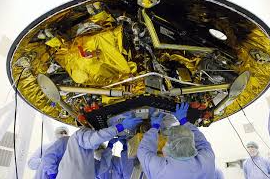
The Euclid mission embarks on a groundbreaking journey to map the invisible forces shaping the cosmos.
A groundbreaking European space telescope has launched on a mission to explore the mysterious and largely invisible domain of the dark universe. On Saturday, SpaceX successfully launched the European Space Agency’s Euclid observatory, setting it on a path to its ultimate destination 1 million miles (1.5 million kilometers) from Earth, in the vicinity of the Webb Space Telescope. The journey will take about a month, with the telescope set to begin its six-year survey of the cosmos by the fall.
Named after the ancient Greek mathematician Euclid, the observatory will map billions of galaxies across more than one-third of the sky. Its primary goal is to uncover the nature of dark matter and dark energy—two invisible forces that together make up the majority of the universe and drive its accelerated expansion. By observing galaxies up to 10 billion light-years away, Euclid aims to provide the most detailed 3D map of the universe ever created.
Euclid’s mission has long been anticipated as a key step in understanding the forces that shape the cosmos. With its ability to measure dark energy and dark matter with unparalleled precision, scientists hope to shed light on the nature of these enigmatic elements. Lead scientist Rene Laureijs emphasised the significance of the mission, stating, “Euclid is more than a space telescope—it’s really a dark energy detector.”
The observatory is equipped with a 1.2-metre telescope and two advanced scientific instruments that will observe the universe in both visible light and near-infrared wavelengths. A large sunshield will ensure that the telescope operates at the necessary low temperatures for accurate observations.
Though originally scheduled to launch aboard a Russian rocket, the geopolitical situation following the invasion of Ukraine led to a shift in plans. Instead, Euclid now rides atop a SpaceX Falcon 9 rocket from Cape Canaveral, avoiding a potential two-year delay had the mission waited for Europe’s new Ariane rocket.
With NASA’s Roman Space Telescope set to launch in 2027 and the Webb Space Telescope joining the effort, these missions will collectively deepen our understanding of dark energy and dark matter, unlocking new chapters in the story of the universe.










